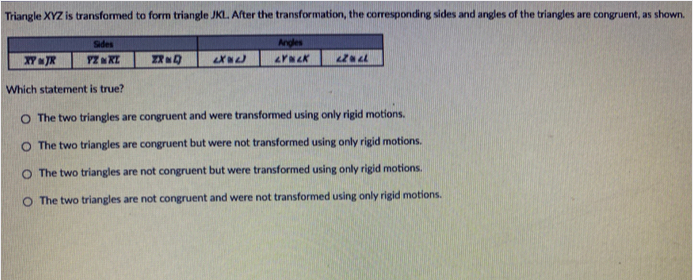Triangle XYZ is transformed to form triangle JKL. After the transformation, the corresponding sides and angles of the triangles are congruent, as shown. Sdes Andes Which statement is true? O The two triangles are congruent and were transformed using only rigid motions. O The two triangles are congruent but were not transformed using only rigid motions. O The two triangles are not congruent but were transformed using only rigid motions. O The two triangles are not congruent and were not transformed using only rigid motions.
Triangle XYZ is transformed to form triangle JKL. After the transformation, the corresponding sides and angles of the triangles are congruent, as shown. Sdes Andes Which statement is true? O The two triangles are congruent and were transformed using only rigid motions. O The two triangles are congruent but were not transformed using only rigid motions. O The two triangles are not congruent but were transformed using only rigid motions. O The two triangles are not congruent and were not transformed using only rigid motions.
Calculus: Early Transcendentals
8th Edition
ISBN:9781285741550
Author:James Stewart
Publisher:James Stewart
Chapter1: Functions And Models
Section: Chapter Questions
Problem 1RCC: (a) What is a function? What are its domain and range? (b) What is the graph of a function? (c) How...
Related questions
Question

Transcribed Image Text:Triangle XYZ is transformed to form triangle JKL. After the transformation, the corresponding sides and angles of the triangles are congruent, as shown.
Sides
Angles
XT JR
Which statement is true?
O The two triangles are congruent and were transformed using only rigid motions.
O The two triangles are congruent but were not transformed using only rigid motions.
O The two triangles are not congruent but were transformed using only rigid motions.
O The two triangles are not congruent and were not transformed using only rigid motions.
Expert Solution
Step 1

Trending now
This is a popular solution!
Step by step
Solved in 2 steps with 1 images

Knowledge Booster
Learn more about
Need a deep-dive on the concept behind this application? Look no further. Learn more about this topic, calculus and related others by exploring similar questions and additional content below.Recommended textbooks for you

Calculus: Early Transcendentals
Calculus
ISBN:
9781285741550
Author:
James Stewart
Publisher:
Cengage Learning

Thomas' Calculus (14th Edition)
Calculus
ISBN:
9780134438986
Author:
Joel R. Hass, Christopher E. Heil, Maurice D. Weir
Publisher:
PEARSON

Calculus: Early Transcendentals (3rd Edition)
Calculus
ISBN:
9780134763644
Author:
William L. Briggs, Lyle Cochran, Bernard Gillett, Eric Schulz
Publisher:
PEARSON

Calculus: Early Transcendentals
Calculus
ISBN:
9781285741550
Author:
James Stewart
Publisher:
Cengage Learning

Thomas' Calculus (14th Edition)
Calculus
ISBN:
9780134438986
Author:
Joel R. Hass, Christopher E. Heil, Maurice D. Weir
Publisher:
PEARSON

Calculus: Early Transcendentals (3rd Edition)
Calculus
ISBN:
9780134763644
Author:
William L. Briggs, Lyle Cochran, Bernard Gillett, Eric Schulz
Publisher:
PEARSON

Calculus: Early Transcendentals
Calculus
ISBN:
9781319050740
Author:
Jon Rogawski, Colin Adams, Robert Franzosa
Publisher:
W. H. Freeman


Calculus: Early Transcendental Functions
Calculus
ISBN:
9781337552516
Author:
Ron Larson, Bruce H. Edwards
Publisher:
Cengage Learning